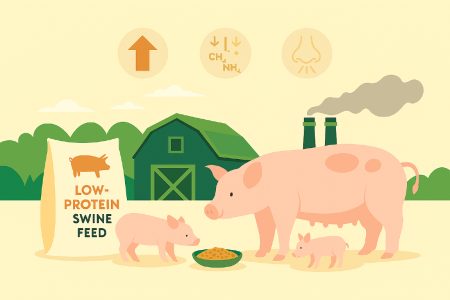South Korea’s swine industry has been shifting toward low-protein diets to reduce nitrogen emissions and improve sustainability, without compromising productivity. The move follows a key regulatory update in July 2022.
The revised law changed crude protein (CP) registration in swine feed. Instead of a minimum requirement, CP levels are now capped to reduced environmental pollution.
Livestock production emits 137 million tons of nitrogen globally annually. Swine farms contribute significantly, prompting Korean researchers to explore feed-based solutions.
A 2024 paper by Hongjun Kim of Seoul National University supports this approach. The study tested reduced CP diets across three swine growth stages.
Experimental trials
Experiment 1 studied how different CP levels affect young pigs’ growth, health, digestion and odor emissions. The study used 240 weaning pigs ([Yorkshire × Landrace] × Duroc), divided into six groups based on sex and starting weight.
Each group followed a randomized complete block (RCB) design and received diets with CP levels ranging from 16/15% to 21/20% during early and late weaning phases.
This experiment measured:
- ✅ Growth performance (feed intake, weight gain, feed efficiency)
- ✅ Blood profiles (including blood urea nitrogen)
- ✅ Diarrhea incidence
- ✅ Nutrient digestibility
- ✅ Odor emissions (ammonia, hydrogen sulfide, amines)
Experiment 2 examined how CP levels affect older pigs’ growth, metabolism, meat quality, and environmental impact. It involved 210 growing pigs of the same crossbreed, divided into six treatment groups using an RCB design.
Each group received phase-specific diets labeled CP1411 to CP1916, representing CP levels from 14/13/12/11% up to 19/18/17/16%.
This trial evaluated:
- ✅ Growth performance and feed efficiency
- ✅ Blood markers (total protein, creatinine, BUN, urea)
- ✅ Nutrient digestibility
- ✅ Pork quality (pH, color)
- ✅ Odor emissions and nitrogen excretion
Experiment 3 focused on how CP levels affect pregnant sows and their piglets. It included 72 multiparous sows (Yorkshire x Landrace) assigned to six dietary treatments in completely randomized design. Diets ranged from 11% to 16% CP.
The study assessed:
- ✅ Sow physiological responses and reproductive performance
- ✅ Blood profiles during gestation and postpartum
- ✅ Milk composition
- ✅ Piglet blood parameters
- ✅ Odor emissions from manure and urine
Lower protein, better outcomes
In weaning pigs, lower CP diets improved feed intake, weight gain, and nutrient digestibility. Diarrhea incidence dropped, and odor emissions were significantly reduced.
Growing-finishing pigs showed similar benefits. Reduced CP improved growth performance and feed efficiency. Blood tests revealed lower metabolic wastes, while pork quality remained unaffected.
Gestating sows maintained reproductive performance on lower CP diets. Odor emissions decreased, and protein metabolism improved without harming sow health or piglet growth.
Environmental and industry impact
Across all trials, reduced CP diets consistently delivered:
- ✅ Improved efficiency and growth
- ✅ Lower blood urea nitrogen and metabolic waste
- ✅ Reduced emissions of ammonia, amines, and hydrogen sulfide
- ✅ Stable pork quality and reproductive outcomes
These results support South Korea’s policy shift and offer a model for sustainable pig production. Precision protein feeding can balance productivity with environmental responsibility.
As climate concerns grow, this approach may inspire similar reforms in other pig-producing nations.

